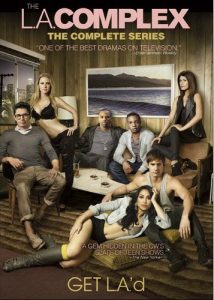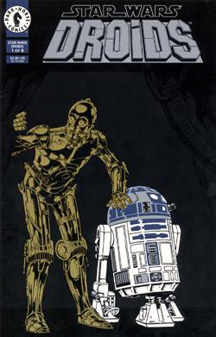While Lucas Books and Dark Horse Comics generally separated their “Star Wars” products into kid and adult categories, sometimes the marketing was a bit off. On the book side, the novels of Kevin J. Anderson fell wrongly into the adult category. On the comics side, Dark Horse’s “Droids” (1994-97) was marketed to readers of “Dark Empire” and “Tales of the Jedi.”
Later in its run, Dark Horse would use digest-sized books to indicate the stories aimed at a younger audience, but “Droids” came out when the company was still finding its footing with “Star Wars.” During its initial release, when I was in high school, I found “Droids” to be bland, and my re-reading reaffirmed that it’s aimed at kids – and it ain’t exactly “Harry Potter.”
Although I’m not a hater of C-3PO and R2-D2, I question whether they’ve earned the substantial amount of solo adventures they’ve starred in, or rather if George Lucas’ personal passion for the characters drove their ubiquity. In the mid-1980s, Nelvana wanted to do a cartoon with the main characters, but Lucas rejected that idea (wanting to save Han, Luke and Leia for stories he’d have a bigger hand in), so the animation studio went with Ewoks and droids, which were fair game. Perhaps a similar thing happened with Dark Horse in the 1990s – although “Dark Empire” told continuing stories of the main characters, the droids allowed writers more freedom from oversight while maintaining the draw of familiar characters.
None of the droids’ stories – whether Nelvana’s, Marvel’s, Dark Horse’s, or the “Clone Wars” “Droids”-style episodes – totally capture what “Droids” should be. “Droids” should be funny, with C-3PO and R2-D2 being an odd couple, only with their human traits being translated into a mechanical world. For example, Threepio says “I’m not programmed for fun!” in “The Protocol Offensive,” which is humorous because it’s so human aside from the fact that he’s programmed rather than reflecting genetic traits. The same goes for Artoo’s constant adventuring and Threepio’s fear of memory wipes (the mechanical equivalent of death). It’s an open secret that the droids have human (or at least organic) personalities – indeed, Anthony Daniels’ portrayal of Threepio and Ben Burtt’s bird-like sounds for Artoo are credited as reasons for the original film’s accessibility.
Yet these Dark Horse comics – “Droids: Special” (reprinted from Dark Horse Presents), “Droids” Series 1 (six issues), “Droids” Series 2 (eight issues), “Artoo’s Day Out” (from Star Wars Galaxy Magazine No. 1) and “The Protocol Offensive” (which doesn’t include the “Droids” logo but is obviously a droids yarn) – are driven by juvenile plots. And while Threepio and Artoo are never out of character (except when Threepio gets temporarily reprogrammed as a brave leader of a rebelling droid army in Series 2), we don’t get genuinely entertaining Laurel & Hardy antics that build on the movies rather than mimicking them. Because the stories are aimed at kids, the villains are of the “Scooby Doo” variety. The bad guys are usually defeated by Artoo or another hero shooting the blaster out of their hand, foiling the evil scheme.

The least bad of this bad batch is “The Protocol Offensive,” as it’s a slightly meatier story about the Tion Hegemony wanting to establish trade with a planet that has two warring factions. Threepio is the interpreter and Artoo provides tech support. Brian Daley completists might want to check it out as it’s based on an outline the great “Han Solo Adventures” and “Star Wars” radio drama author penned before his death. While Ryder Windham (responsible for many of the bland “Droids” issues) wrote the story, Daniels chipped in on Threepio’s dialogue and he does a nice job.
The other “Droids” titles also include nods to other “Star Wars” stories. For example, the droids travel to the “Han Solo Adventures” Corporate Sector planet Etti IV and the “Dark Empire” world Nar Shaddaa. But the art isn’t particularly good, so even those tie-ins aren’t as cool as they could be. In the “Special,” IG-88 menaces the droids, but writer Dan Thorsland somehow makes the famous assassin droid tame and boring.
Although they don’t hold up on re-watches, I hold a soft spot for the 1980s “Droids” cartoons, so these comics could’ve won some easy points with me with further exploration of those characters and worlds. But we get none of that. It’s another missed opportunity in a series that should’ve been a smorgasbord of fun stories and funny droid antics but continually falls flat.
(Note: Completists will also want to track down “The Mixed-Up Droid” and the “Droids” Apple Jacks special, both of which can be found in the “Wild Space” Volume 1 omnibus.)

